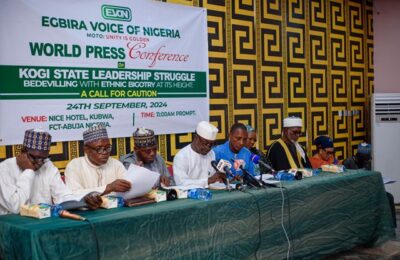I have heard and read a lot about the National Iron-Ore Mining Company (NIOMCO), Itakpe and Ajaokuta Steel Company Limited (ASCL) but I saw their true state for the first time in early May when I, in company of about 50 journalists, visited the gigantic complexes on a fact-finding mission. I was a rapporteur of a 3-Day Media Immersion Workshop organised for journalists and reporters covering the mining sector organised by the Ministry of Mines and Steel Development in conjunction with a Non-Governmental Organisation, OSIWA.
The original conceivers of NIOMCO meant well for the country. At the site of iron ore belt, there is a deposit of about 200m tonnes of iron ore of 4km stretch both on the surface and underground. Not one percent of this has been mined. We visited the blending yard that blends the ore with other minerals to give the same volume. The power station gets supply from Ajaokuta power substation which is 52kms away, but hoodlums are vandalising the copper cables. The repatriation bin is where the reclaimed mineral is sent to this mill. The iron at the site is what is called iron ore and other minerals. There is a dam, wagons, rail network, machines and other installations. NIOMCO is to supply Ajaokuta Steel plant input materials for production of steel.
NIOMCO was small compared to Ajaokuta. What I saw in Ajaokuta left me speechless and sad till now. How could we as a nation, leave such a cash cow to waste away just because past leaders could not get their acts together and harness the great potentials of the gigantic edifice which is rightly described as “the bedrock of Nigeria’s industrialisation” ? The size of the complex is on a 24,000 hectares land area. The steel plant occupies 8,000 hectares with other underground equipment as big as the ones on the surface. It was expected to engage about 10,000 direct employees and create 500,000 indirect jobs in the upstream, downstream and side stream segments. Nigeria imports 20 million tonnes of steel and allied products worth N6tn annually. Ajaokuta can correct this normally if operational. Ajaokuta can support all our airports, stadia, cement company, armoury, agro-allied companies. It can also service Aladja, Katsina, Jos and Osogbo Steel rolling mills!
South Korea which started its steel construction around the same time now has a revenue base of over N60b dollars per annum and employed over 65,000 staff. Ajaokuta would have done better if it had started production or had been completed within the initial scheduled time. Reportedly, the plant had been completed 98 percent in the last 23 years (1994) but all these are not put into use. Just like NIOMCO, Ajaokuta Steel plant has been encumbered by legal bottlenecks which has recently been resolved while the company is expected to start production as soon as possible. The present administration through the present minister, has released money for equipment maintenance while concession, outright sale, privatization and joint venture options are being considered.
We should salute the courage and vision of ex-President Shehu Shagari who started and built the complex up to 84% since 1983 while it was only completed to 98% in 1994. We were told he personally monitored the progress of the steel plant construction by visiting the complex every month. It is sad that a complex which had been completed 84% since 1983 is yet to commence production 34 years after.
Words are not enough to describe the huge size of the complex and the highly sophisticated assemblage of the 43 different plants made up of a web of complex iron, cable and machinery of different sizes and functions. Out of the 43 plants, 40 are already completed and can produce independently. However, what is delaying production, according to our tour guide, is that steel plants are either sea or rail based. When a plant is commenced, you cannot stop it until about seven years. This means all the materials needed must be readily available. In fact, it will take about six months to shut down any of the plants!
Ajaokuta is unarguably Nigeria’s biggest investment in one location. The internal rail line of the complex covers about 54 kilometres while the total length of the steel complex is about 24 kilometres. Six thousand housing units have been completed out of the 10,000 planned for the staff. Ajaokuta is not just a rolling mill but an integrated iron and steel plant. It has four rolling mills namely; the Billet Mill which produces billets; the Light Section Mill which produces round, square, strip and angles metals; the Wire Rod Mill which produces wire rods and rebars used in construction companies and production of nails, fencing wire, rope mesh, bolts and nut and netting; and, the Medium Section and Structural Mill which produces parallel flange channels, equal angles, unequal angles and standard channels. In fact, each of the four rolling mills is bigger than Aladja, Osogbo, Katsina and Jos rolling mills put together while the coke oven and bye products plant is bigger than all the four refineries in Nigeria put together.
The good news however is that the equipment in the plants is being serviced except for some replacement of parts so it can start working as soon as running fund is made available. A total of $4.6 billion has been sunk on the plant since inception while an additional, $2billion is required to complete the remaining plants and for running costs to start production. In 2016, 1.6 million metric tonnes of steel was produced using the blast furnace system. The equipment is constantly maintained since installation in 1983 and this explains why the workers remained on federal government payroll since then. The recent audit report certified the equipment fit for production.
From the information available at the workshop and with what I saw at Itakpe and Ajaokuta plants, the jinx holding back the companies may be about to be broken through the efforts of the present ministers who have worked assiduously to revive the ailing plants and make the mining sector as a whole, vibrant. Part of this is the acquisition of wide format scanner to safeguard drawings. Jaw crusher was also purchased while some machines were recovered and others rehabilitated. The effort has also resulted in securing a N30b intervention fund from the federal government for the mining sector and US$150m from the World Bank.
Inter-ministerial cooperation has been assured at the National Mining Conference in Abuja with the federal government directive for the removal of bottlenecks in the mining sector and enacting enabling laws, policies that are investor friendly. The sector has grown by 6% quarter-on-quarter in the last five quarters despite the recession and the acting President, Prof. Yemi Osibajo alluded to this when he said the Ministry of Mines and Steel Development under Dr. Kayode Fayemi is performing.
The ministry, in its roadmap, recently said it will contribute about $27bn (N9.7tn) to the Gross Domestic Product by 2025. Nigeria is now more active than before in raising awareness of the opportunities it presents to the industry with attendance at several mining conferences in the country and across the world where it showcases to international investors, the available opportunities in the sector.
There is a great potential to be harnessed in the mining sector as the internal market is not even saturated. Even though we have more mineral resources which we have jettisoned for oil, we are not a mining nation and this will change soon if the present administration can maintain the current pace of development in the sector. If Itakpe and Ajaokuta can start operation, the economy of Nigeria will improve dramatically as it will become a major foreign exchange earner and signal the beginning of the industrialisation of Africa’s largest economy.
– Hakeem Jamiu wrote from Lokoja, Kogi State.




